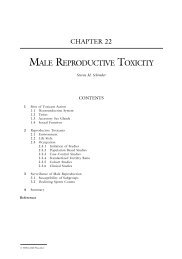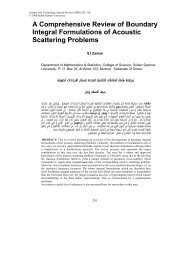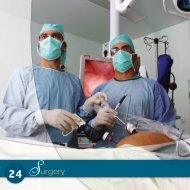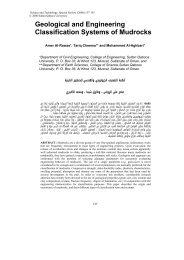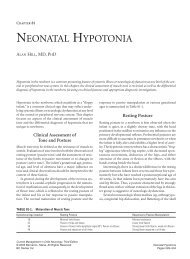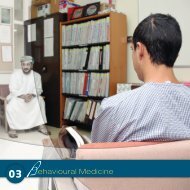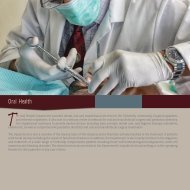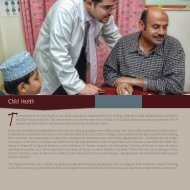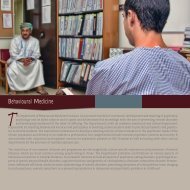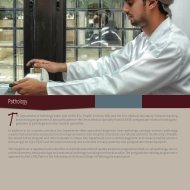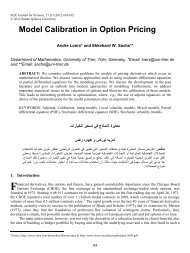Ch11: Adverse Drug Reactions - SQU Home
Ch11: Adverse Drug Reactions - SQU Home
Ch11: Adverse Drug Reactions - SQU Home
You also want an ePaper? Increase the reach of your titles
YUMPU automatically turns print PDFs into web optimized ePapers that Google loves.
108 CHAPTER 11Table 11–2Significant <strong>Drug</strong>–Physiology InteractionsUndesiredDesired Dental Physiologic Response<strong>Drug</strong> Response (In Dental Settings)Aspirin Analgesic BleedingBarbiturates Sedative Respiratory depressionNarcotics Analgesic Respiratory depressionVasoconstrictors Localize anesthetic Increase cardiacsolutionexcitabilitytist. For example, the antiprostaglandin effect of aspirinalso prevents platelets from adhering. Therefore, a sideeffect or drug–physiology interaction may be excessivebleeding. Such drug–physiology interactions are relativelycommon, but significant ones, those that are lifethreatening,occur only with a few drugs used in dentistry(Table 11–2).The second drug–physiology interaction is toxicity.This adverse drug reaction is associated with the dose ofthe drug and may be an extension of its therapeutic effector may be an effect on another system. Toxic effects ofdrugs should not happen, since most drugs used in dentistryhave a wide margin of safety between the therapeuticdose and the toxic dose. The most common reasonfor drug overdose is a failure to take into account the sizeof the patient; overdose toxicity is more common in childrenand the frail elderly. The second most common reasonfor overdose is failure to adjust dosing to take intoaccount the patient’s inability to metabolize or eliminatethe drug. Therefore, if the dentist is aware of the properdose and alert to the patient’s size as well as their liverand kidney function, chances of overdosing are minimized.The practitioner must also keep in mind that thepatient may be taking other medication, especially overthe-countermedication, which may have additive toxicityto the medication used in dentistry.<strong>Drug</strong>–drug interactionsThe classic drug–drug interactions comprise four differentaspects of drug pharmacodynamics: absorption, distribution,metabolism, and excretion. Absorption is nota crucial aspect when discussing adverse drug reactionsin dentistry. It is possible that food in the stomach maylower the absorption rate, but neither final blood levelnor therapeutic effect is substantially altered. All drugsgiven for dental purposes, at the appropriate dosage,should eventually be adequately absorbed to obtaintherapeutic blood levels. Certainly, if the patient regurgitatesthe bulk of the drug, then therapeutic blood levelscannot be obtained, and it may be necessary for thepatient either to retake the drug or to receive it parenterally.In patients with malabsorption, extensive colitis,or other gastrointestinal problems, the dentistshould consult with the patient’s physician to establishways of ensuring that necessary medications are given insuch a way that therapeutic blood levels are achieved.<strong>Drug</strong> distribution in the body has the potential toinitiate adverse reactions. Some drugs are bound toplasma proteins; once at the site of action, the therapeuticeffect is created by the free drug. A drug administeredby the dentist may have a higher affinity for theplasma protein, and will therefore displace the drugalready bound. This will cause higher concentrations ofthe original drug in the plasma and a possible toxicityreaction. This primarily occurs with highly proteinboundmedical drugs that have narrow therapeutic marginsof safety, such as the anticoagulant, dicumarol.For drugs used in dentistry, problems associatedwith excretion are important only for those patientswith significant kidney problems. When the kidney isnot functioning properly, any drug excreted by the kidneyis excreted more slowly. This decrease in excretionrate may allow blood levels to rise to potentially toxiclevels. Some dental drugs can have a toxic effect on specificorgans, including the kidney and liver. For patientswith liver and kidney problems, dental drugs should bechosen so as to have minimum impact on the diseasedorgan (Table 11–3).The most important area of drug–drug interactionsis drug metabolism. Most drugs given in dentistry andmost drugs given for medical purposes are metabolizedby enzymes in the liver. The primary group of metabolizingenzymes is called the cytochrome P-450 system.These are areas in liver cells that act as latticed processingstations. These surfaces are coated with variousenzymes. The cytochrome P-450 enzyme system is subdividedinto isoenzyme groups. The enzymes metabolizea wide range of compounds. Some drugs induce the synthesisof these enzymes, thereby accelerating their ownmetabolism and the metabolism of other drugs. Somedrugs inhibit these metabolizing enzymes, thereby slowingtheir own metabolization or slowing the metabolizationof other drugs. The most serious drug–druginteractions are related to either inducing or inhibitingisoenzyme groups within the cytochrome P-450 system.In dentistry, four drugs, the antibiotics, erythromycin,clarithromycin, metronidazole, and the antifungal drug,ketoconazole, are known inhibitors of cytochrome P-450 enzymes (Table 11–4). When using any of theseTable 11–3Dental <strong>Drug</strong>s with Toxic Effects on Specific Organs<strong>Drug</strong> Use Affected OrganAcetaminophen Analgesia LiverCorticosteroids Anti-inflammatory Immune systemKetoconazole Antifungal Liver
ADVERSE DRUG REACTIONS 109four drugs, the dentist should be alert to whether thepatient is taking any other medication and be preparedto evaluate a possible interaction. It might be appropriateto choose a different drug to treat the oral problem.<strong>Drug</strong> allergiesIn dentistry, drug allergies are the most common adversedrug reaction encountered. Patients frequently claim tohave allergies to penicillin, aspirin, or codeine. A trueallergic reaction is an immune system-mediated responseto an allergen. Almost any drug or compound can be anallergen. (Actually most drugs are too small to be antigenicby themselves and must combine with a carrierprotein, or hapten, to create an allergic response.) Mostsevere allergic reactions are immediate type, humoral (Bcell) antibody-mediated reactions. The allergen (drug)exposure precipates an antibody response, and the resultantcascade of events includes histamine release thatcauses swelling, redness, and itching (urticaria). Mostcommonly, this manifests as a rash on the body, butinfrequently it manifests as perioral swelling (angioneuroticedema) or swelling in the throat adequate to restrictor prevent breathing (anaphylaxis). Delayed allergicreactions are mediated through the cellular (T cell)branch of the immune system, and these usually manifestas skin rashes, blisters, and at times, oral ulcerations.Dental managementThe primary approach to allergic reactions is to avoidthem by obtaining a thorough patient health historywith respect to allergic reactions. The dentist shouldinterview the patient about allergies, especially allergiesto medications commonly used in dentistry, includingantibiotics, pain medications, or local anesthetics. Trueallergic reactions to local anesthetic are extremely rare,and, even then, it is usually a reaction to the preservative;nevertheless, this information is necessary to avoidan adverse response to dental treatment.Table 11–4 <strong>Drug</strong>s Used in Dentistry that Alter Cytochrome P-450EnzymesEffect on Cytochrome<strong>Drug</strong> Use P-450 EnzymesErythromycin Antibiotic InhibitKetoconazole Antiflangal InhibitClarithromycin Antibiotic InhibitMetronidazole Antibiotic InhibitBarbiturates Sedative StimulateDexamethasone Steroidal Stimulateanti-inflammatoryWhen a patient claims to have had an allergic reaction,further questioning is necessary. If the patient hasexperienced a true immune system-mediated allergicreaction, such as redness, swelling, rash, or itching, thedrug should be avoided. If the “allergic reaction” wasactually an adverse physiologic response to the drug orthe dental experience, such as stomach upset, dizziness,or nausea, which do not constitute an immune systemmediatedreaction, it is not a true allergy. Still, the drugshould be avoided, if possible, because the patient’s nextexposure may precipitate a true allergic response, or itmay precipitate the same adverse physiologic responsethe patient reported. In any event, the patient will beupset at having been exposed to a drug to which he orshe reported having an “allergy.”Allergic responses are treated by withdrawal of thedrug and possibly antihistamines or corticosteroids.Depending on the severity of the reaction, as in the caseof laryngeal swelling (anaphylaxis), it may be necessaryto give an injection of epinephrine to physiologicallyreverse the allergic response.The management of patients in a dental setting, tominimize the risk of other adverse drug reactions, hastwo aspects. The first is to avoid adverse drug reactionsby identifying the patient who is at high risk. The secondis to understand which specific drugs have thegreatest probability of causing adverse drug reactions.The practitioner should be aware that some patients areat much higher risk of adverse drug reactions than others.Identifying these patients and treating them accordinglyis the most effective way to minimize risk. Patientsat greatest risk are those taking multiple medications,those who are medically compromised, and those whoare taking specific medications that are closely titratedand have a narrow therapeutic index. The therapeuticdose of highly titrated drugs is just slightly less than thedose that causes adverse reactions. These drug groupsare the following:1. Anticoagulants2. Anticonvulsants3. Hypoglycemics4. Cardiac glycosides5. LithiumIt is estimated that medically complex patients,depending on the definition used, comprise from 15%to 25% of the average dental practice. The higher estimateincludes in the definition of medically complexpatients, cigarette smokers and patients over 55 years ofage. More traditionally, the definition applies to thosepatients on multiple medications, those who have multiplemedical problems, and patients under the age of 14years and those older than 65 years. Certainly the decisionas to whether a person is medically complexshould be taken on a case-by-case basis, and varies
110 CHAPTER 11with the medical problem as well as the dental procedurebeing undertaken. Relative to adverse drug interactions,special consideration should be given to thosepatients who are taking highly titrated drugs. Patientstaking Synthroid to normalize their thyroid levels andeven those taking blood pressure medications that renderthem normotensive, though they would be consideredmedically compromised, are at low risk for adversedrug reactions in a dental setting.The other way of avoiding adverse drug reactions isto understand the drugs used in dentistry, their metabolism,effects, side effects, and toxicities. Few drugs areused in dentistry; the prescriber should know their usesand the safe maximum dose. It is not the dentist’sresponsibility to understand the effects, side effects, toxicity,and metabolism of all the medical drugs thepatient may be using, but to understand how dentalprocedures and dental drugs impact the patient and themedication he or she is taking. This may be done in consultationwith the patient’s physician, though the dentistshould not expect the physician to understand dentalprocedures nor the drugs used in dentistry. It is the dentist’sresponsibility to be aware of any medical drugsknown to interact with drugs used in dentistry.Many drug interactions are theoretically possible, butfew are probable, and of the drug interactions that areprobable, even fewer are serious. The adverse drug reactionsnoted here are considered probable; that is, theyoccur in more than 3% of patients. With awareness ofthese adverse drug reactions, familiarity with patients’health status, and use of proper drug dosage, the dentistcan essentially eliminate the risk of adverse drug reactions,especially drug–drug and drug–physiology interactions.ResourcesThis chapter is designed as a partial overview of adversedrug reactions. It provides precautions and informationthat should be adequate for the average practitioner toavoid 95% of the potential adverse drug reactions thatcould occur in dentistry. The resources listed in Table11–5 provide additional specific information on certaintopics, including tables on adverse drug reactions thatare considered probable (ie, interactions have beenreported in the scientific literature). <strong>Adverse</strong> drug reactionsconsidered possible (ie, theoretically could occurbut are not documented) also can be found in the Journalof the American Dental Association series on adversedrug reactions (see Table 11–5). As information availableon the Internet evolves, there is no doubt that themost current information and the most accurate dataavailable on adverse drug reactions will be accessiblethrough a variety of Web sites. (Table 11–6 lists someTable 11–5Resources Regarding <strong>Adverse</strong> <strong>Drug</strong> ReactionSpecific series on dental drug interactionsMoore PA, Gage TW, Hersh EV, et al. <strong>Adverse</strong> drug interactions indental practice: professional and educational implications. J AmDent Assoc 1999;130:47–54.Hersh EV. <strong>Adverse</strong> drug interactions in dental practice: interactionsinvolving antibiotics. J Am Dent Assoc 1999;130:236–51.Haas DA. <strong>Adverse</strong> drug interactions in dental practice: interactionsassociated with analgesics. J Am Dent Assoc 1999;130:397–407.Moore PA. <strong>Adverse</strong> drug interactions in dental practice: interactionsassociated with local anesthetics, sedatives, and anxiolytics.J Am Dent Assoc 1999;130:541–54.Yagiela JA. <strong>Adverse</strong> drug interactions in dental practice: interactionsassociated with vasoconstrictors. J Am Dent Assoc 1999;130:701–9.Useful booksWynn RL, Meiller TF, Cossley HL. <strong>Drug</strong> information handbook fordentistry. 5th Ed. Hudson, Ohio: Lexi-Comp, 1999–2000.Web sites that are available for on-line inquiries aboutadverse drug reactions.) The dentist should select one ortwo sites, list them in “favorites,” and learn to workeffectively within them to gather necessary information.Two of the sites listed have search features that can beused to find information about specific drugs. This isespecially important for new drugs that are just beingreleased. These resources often provide a superabundanceof information; it is the professional responsibilityof each practitioner to identify the information thatis relevant to the circumstances of each patient.Table 11–6 Internet Web Site Resources for <strong>Drug</strong>s and<strong>Drug</strong> Interaction Informationwww.medscape.com. This is a searchable site or an extensivemedical-based home page that can be customized forpersonal interest. It will send topics, such as pharmacology,updates to your computer, to allow you to keep current onareas of interest.www.fda.gov/opacom/hpchoice.html. This site within FDAprovides information on adverse reactions.www.nlm.nih.gov. This site has a powerful search featurethat looks at a large range of databases and searches outcomplete articles on specific topics.www.ada.org. The American Dental Association Web site containsresources and connects to a variety of medically relatedsites. Members can look through a long, well-researchedlist of useful Web sites related to drugs and health.www.healthgate.com. This site provides access to medicinesearches as well as health news.www.dentalgate.com. This site has two different searchfeatures, one for the World Wide Web and another formedicine, especially designed for dentistry.





